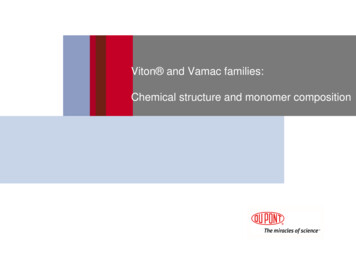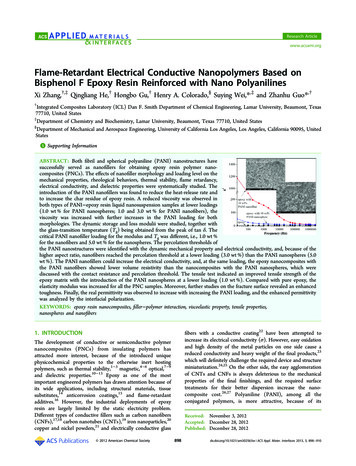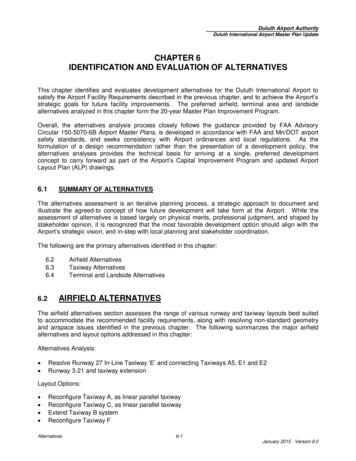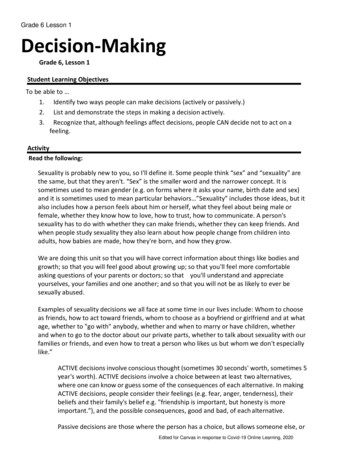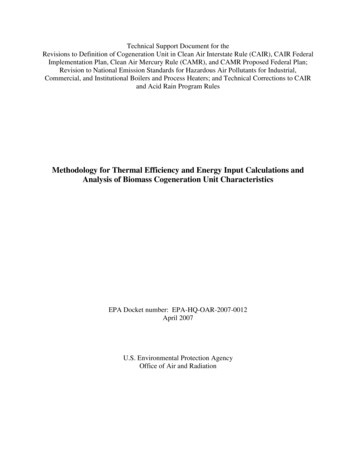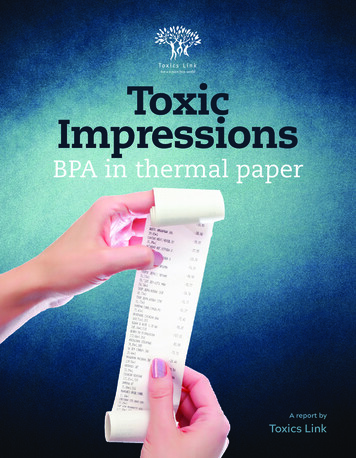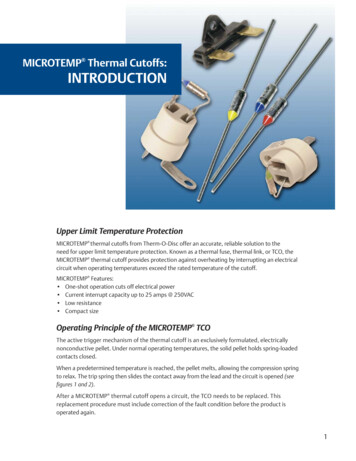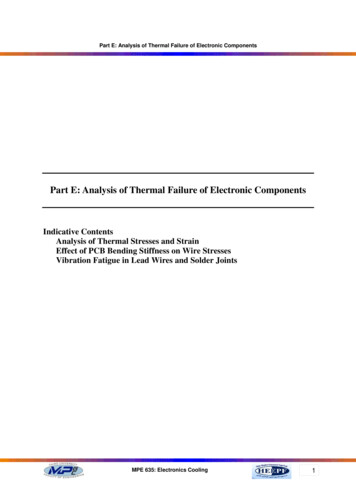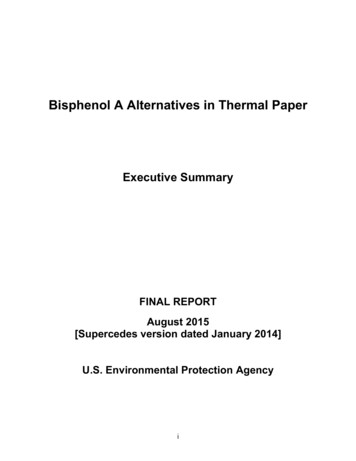
Transcription
Bisphenol A Alternatives in Thermal PaperExecutive SummaryFINAL REPORTAugust 2015[Supercedes version dated January 2014]U.S. Environmental Protection Agencyi
Executive SummaryThis report provides information on bisphenol A (BPA), its use in thermal paper, and possiblesubstitutes for this use. The report was developed by the U.S. Environmental Protection Agency(EPA) with input from stakeholders from business, government, academia, and environmentalorganizations. Based on conversations with technical experts, including stakeholders, weidentified nineteen alternatives that are potential functional substitutes for inclusion andassessment. In addition to information on potential hazards of BPA and possible substitutes,information on the trade-offs associated with each alternative is presented for consideration insubstitution decision-making.BackgroundIn March 2010, EPA released a chemical action plan for BPA. BPA is a high production volume(HPV) chemical that is used in manufacturing most polycarbonate plastics, the majority of epoxyresins, and other uses subject to regulation under the Toxic Substances Control Act. The actionplan summarizes hazard, exposure, and use information, and identifies actions to address BPAin the environment based on concerns for potential effects on aquatic species. 1 BPA is also acommonly used developer in a number of thermal paper applications, such as point-of-sale(POS) receipts. The developer is a component of a chemically reactive layer of thermal paper,which reacts in the presence of heat to create the printed image. When used in thermal paper, BPAis present as “free” (i.e., discrete, non-polymerized) BPA, which is likely to be more available forexposure than BPA polymerized into a resin or plastic (U.S. EPA 2010).One component of the action plan tasked the EPA Design for the Environment (DfE) Branch toconduct an alternatives assessment for BPA in thermal paper. Thermal paper was selected forevaluation based on concern for potential exposures to consumers and workers, releases to theenvironment, and stakeholder interest. DfE’s Alternatives Assessment Program provides a basisfor informed decision-making by developing a semi-quantitative, screening-level comparison ofthe potential human health and environmental impacts of chemical alternatives. DfE AlternativesAssessments provide information on functional use class, intrinsic hazard, exposure properties,and environmental fate for chemical alternatives. Information from DfE AlternativesAssessments can support the selection of safer alternatives when combined with otherinformation not addressed in DfE Alternatives Assessments, such as performance, cost, andlife-cycle impacts.Goal of the Alternatives Assessment and Report OverviewIn July 2010, DfE convened a multi-stakeholder effort to assess the human health andenvironmental effects of BPA and its alternatives as developers in thermal paper. This informalpartnership includes a diverse array of stakeholders, such as thermal paper manufacturers,thermal paper converters, chemical manufacturers, POS equipment manufacturers, retailers,trade associations, non-governmental organizations (NGOs), green chemistry and technicalexperts, and international governmental organizations. The outcome of this effort is presented inthis report. The report provides information that will help decision-makers consider1The U.S. Food and Drug Administration (FDA) is expected to take the lead on assessing potential human healthimpacts associated with exposure to BPA. See .htm.ii
environmental and human health profiles for all evaluated chemicals so that they can choosesafer functional alternatives and take into account potential hazard trade-offs that may exist.Chapter 1 of this report provides background information on BPA and defines the report’spurpose and scope. Chapter 2 discusses information on BPA and its use in thermal paper as adeveloper. Chapter 3 offers background information on the thermal paper printing system andhow developers interact with other components in the system to create a printed product. Chapter4 explains the hazard evaluation methodology and includes the hazard profiles for BPA and thealternatives. Chapter 5 provides exposure information and life-cycle considerations for BPA.Chapter 6 discusses considerations for selecting thermal paper developers and provides relevantresources for moving towards a substitution decision.Hazard Evaluation of BPA and AlternativesGiven that the project scope is limited to BPA’s use as a developer in thermal paper, thisalternatives assessment does not consider alternatives to BPA for other uses. In addition toBPA, 19 potential chemical alternatives were identified for evaluation, which were consideredby stakeholders likely to be functional in thermal paper. The assessment evaluated threegeneral attributes to inform decision-making on chemical alternatives: (1) human healtheffects, (2) ecotoxicity, and (3) environmental fate. The evaluation was conducted according tothe DfE Alternatives Assessment Criteria for Hazard Evaluation, which is a transparent tool forevaluating and differentiating among chemicals based on their human health and environmentalhazards. For most endpoints, the criteria define “High,” “Moderate,” and “Low” concern. Veryfew chemicals had measured data for all endpoints; therefore, estimation methods were appliedto fill data gaps. Since estimation methods come with a lower degree of confidence, thiscircumstance may be an important consideration for decision-making. No clearly saferalternatives to BPA were identified in this report – most alternatives have Moderate or Highhazard designations for human health or aquatic toxicity endpoints. Persistence andbioaccumulation potential were not distinguishing for this group of alternatives.The human health effects endpoints evaluated in DfE Alternatives Assessments include acutetoxicity, carcinogenicity, genotoxicity, reproductive toxicity, developmental toxicity,neurotoxicity, repeated dose toxicity, skin sensitization, respiratory sensitization, eye irritation,and dermal irritation. Qualitative discussions on available endocrine activity and immunotoxicitydata were included, where relevant. All chemicals (including BPA) had Low designations foracute mammalian toxicity. Eight chemicals had High designations for developmental toxicity.For repeated dose toxicity, five chemicals had a High designation. Thirteen chemicals hadModerate, High, or Very High designations for at least one of the irritation and sensitizationendpoints. All chemicals were assigned Moderate concern for carcinogenicity. Six chemicalswere assigned Moderate concern for genotoxicity, with the remaining chemicals being of Lowconcern for this endpoint.The ecotoxicity endpoints evaluated in DfE Alternatives Assessments include acute and chronicaquatic toxicity. Ecotoxicity data for terrestrial species is limited. Most of the alternatives hadHigh designations for aquatic toxicity (acute and chronic).Environmental fate of BPA and the 19 alternatives were also evaluated. Three of the20 chemicals had Low or Very Low persistence values; 11 had High or Very High persistencevalues. Only two chemicals had a High bioaccumulation potential.iii
For a screening-level summary of the hazard evaluations for alternatives (including BPA), seeTable ES-1 below.General Exposure and Life-Cycle FactorsEnvironmental exposure to BPA or alternatives may occur during manufacture, conversion, oruse of thermal paper, at its end-of-life (i.e., recycling, landfilling, or incineration), or duringmanufacture of recycled paper products. Understanding the factors that affect exposure to BPAand alternative developers across their life-cycles provides additional context to the alternativeselection process. There is a potential for occupational exposure during chemical and productmanufacturing and product end-of-life. Additionally, there may be exposures to workers andconsumers while thermal paper is being used and to the general population and the environmentfrom releases during product manufacturing, use, and end-of-life.Considerations for Selecting Thermal Paper DevelopersAlong with presenting information on hazard to inform substitution decisions, the reportdiscusses considerations for selecting thermal paper developers, including opportunities forinnovation and design challenges. Options that may be considered for substitution include thedevelopment of new chemicals that have a preferable hazard profile while still meeting theperformance considerations required by particular applications. Another option would be tore-design thermal paper to eliminate the need for chemical developers. In addition toreconfiguring thermal printing systems, decision-makers may wish to consider alternativeprinting systems. These systems should be evaluated and compared to thermal printing to betterunderstand relative performance, cost, and hazard. Finally, another option would be the use of ereceipts. A full examination of the relative merits of thermal paper versus e-receipts wouldrequire the consideration of life-cycle impacts, which is beyond the scope of this study.How to Use This ReportThe intended audience for the report includes, but is not limited to, chemical manufacturers,product manufacturers, retailers, consumers, NGOs, consultants, and state and federal regulators.Four possible uses of this report include: (1) identification of potential substitutes, (2) selectionof alternative chemicals based on comparative hazard assessment, (3) incorporation of hazardinformation for further analysis and decision-making, and (4) as a baseline for the developmentof new and safer chemical substitutes.This report allows stakeholders interested in chemical substitution to identify functionalsubstitutes for BPA in thermal paper. The list of potential alternatives introduced inChapter 3 includes chemicals identified by stakeholders as likely to be viable, functionalalternatives as well as chemicals that are not considered functional alternatives, which weresubsequently removed from consideration. The inclusion of a chemical in this assessment doesnot indicate environmental- or health-based preferability. By identifying potential functionalalternatives, this report assists manufacturers in selecting chemicals for additionalperformance testing.Chapter 4 contains human health and environmental profiles for each chemical. Decision-makerscan use this information to understand and compare the hazard concerns associated withpotential alternatives, and it may help businesses avoid the cost of repeated substitution. Someiv
alternatives may be associated with hazard concerns similar to those of BPA, while others maybe associated with different hazard concerns. The profiles in Chapter 4 can help decision-makersunderstand which potential alternatives may come under scrutiny in the future.In addition to reading the hazard summary table (ES-1), decision-makers should review the fullhazard assessments for each chemical available in Section 4.2 of the report. The hazardassessments provide more information on hazard criteria, data interpretation, and informationused to assign hazard values in each category. Decision-makers should consider this informationto ensure a complete understanding of the hazard profiles of each alternative.The information in this report can be used to inform further analyses on preferred alternativechemicals, such as risk assessments or life-cycle assessments. For example, a decision-makercould identify several preferred functional alternatives and conduct product-specific riskassessments based on exposure expectations along the product’s life-cycle. This type ofsupplementary information may be helpful in guiding product-specific decision-making. Thecriteria used to develop the hazard assessments in this report can also be used to inform greenchemistry design, if availability of safer alternatives is limited.Many of the chemicals have significant data gaps; while estimation methods can be used toaddress these data gaps, access to high quality, relevant toxicological and environmental fatedata is preferred as it provides more robust assessments. Chemicals used at high volumes, orlikely to be used at high volumes in the future, should be of high priority for further testing. Thefull hazard assessments for each chemical, available in Chapter 4, may inform whether additionalassessment or testing is needed.v
ES-1 Screening Level Toxicology Hazard Summary for BPA and AlternativesOHOMMMMMHHVLLBisphenol M§MHLLBisphenol L§MMM§H§MM§M§H§M§HHMMMBHAMethyl MBisphenol ML§M§H§MM§M§M§M§HHHMSubstituted phenolic compound,PROPRIETARY #1L§MLM§H§MM§M§M§M§HMMLSubstituted phenolic compound,PROPRIETARY �LPHBBBenzyl nogenicity80-05-7CASRNAcute HOAcuteOHODermal IrritationOHOEye IrritationOHHOSkin SensitizationOHHOBisphenol A2,2-bis(p-hydroxyphenyl)propaneChemical(for TSCA inventory name andrelevant trade names see theindividual profiles in Section 4.8)StructureHORepeated DoseThis table only contains information regarding the inherent hazards of the chemicals evaluated. Evaluation of risk considers both the hazard and exposure.The caveats listed in the legend and footnote sections must be taken into account when interpreting the hazard information in the table below.VL Very Low hazard L Low hazard M Moderate hazard H High hazard VH Very High hazard Endpoints in colored text (VL, L, M, H, and VH)were assigned based on empirical data. Endpoints in black italics (VL, L, M, H, and VH) were assigned using values from estimation software and professionaljudgment.§Based on analogy to experimental data for a structurally similar compound.AquaticEnvironmentalHuman Health EffectsToxicityFateBisphenol A and Phenolic Alternatives94-18-8vi
ES-1 Screening Level Toxicology Hazard Summary for BPA and Alternatives cinogenicityLBisphenol S4-Hydroxyphenyl sulfoneCASRNAcute OAcuteOHSDermal IrritationOHOEye IrritationOHO OSSkin SensitizationOS80-09-1Chemical(for TSCA inventory name andrelevant trade names see theindividual profiles in Section 4.8)StructureHORepeated DoseThis table only contains information regarding the inherent hazards of the chemicals evaluated. Evaluation of risk considers both the hazard and exposure.The caveats listed in the legend and footnote sections must be taken into account when interpreting the hazard information in the table below.VL Very Low hazard L Low hazard M Moderate hazard H High hazard VH Very High hazard Endpoints in colored text (VL, L, M, H, and VH)were assigned based on empirical data. Endpoints in black italics (VL, L, M, H, and VH) were assigned using values from estimation software and professional judgment.§ Based on analogy to experimental data for a structurally similar compound.AquaticEnvironmentalHuman Health EffectsToxicityFateHydroxyphenyl Sulfone Alternativesvii
ES-1 Screening Level Toxicology Hazard Summary for BPA and Alternatives (Continued)Eye IrritationDermal §HHHLPergafast ne151882-81-4LMLLLLMLLLHHHLUUUrea Urethane Compound321860-75-7LMLLLLLLLLLL VHLRespiratorySensitizationSkin icityD-90Phenol, 4,4’-sulfonylbis-, polymerwith 1,1’-oxybis[2-chloroethane]Chemical(for TSCA inventory name andrelevant trade names see theindividual profiles in Section 4.8)Acute ToxicityRepeated DoseThis table only contains information regarding the inherent hazards of the chemicals evaluated. Evaluation of risk considers both the hazard and exposure.The caveats listed in the legend and footnote sections must be taken into account when interpreting the hazard information in the table below.VL Very Low hazard L Low hazard M Moderate hazard H High hazard VH Very High hazard Endpoints in colored text (VL, L, M, H, and VH) wereassigned based on empirical data. Endpoints in black italics (VL, L, M, H, and VH) were assigned using values from estimation software and professional judgment. The highest hazard designation of a representative component of the oligomeric mixture with MWs 1,000.‡ The highest hazard designation of any of the oligomers with MW 1,000§ Based on analogy to experimental data for a structurally similar compound.AquaticEnvironmentalHuman Health EffectsToxicityFateOligomeric and Polymeric AlternativesHOOSOOOOSOOO HnSOSOOHHOOOH3COHS NOOO O OSNNNHCH3SOONO OSNviii
information not addressed in DfE Alternatives Assessments, such as performance, cost, and life-cycle impacts. Goal of the Alternatives Assessment and Report Overview . In July 2010, DfE convened a multi-stakeholder effort to assess the human health and environmental effects of BPA and its alternatives as developers in thermal paper. This informal
